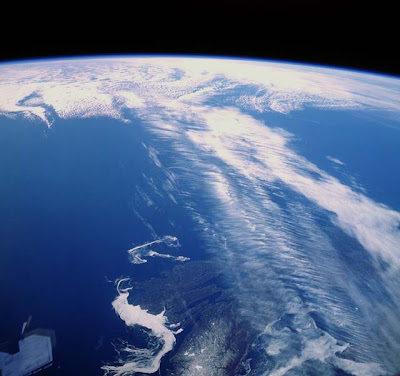ABC of Weather: Jet Stream

This photograph (courtesy of Solar Views) was taken from the Space Shuttle whilst at around 200 miles (320 kilometers) above the Earth. It shows a band of cirrus clouds produced in this instance by a westerly jet stream stretching across the Red Sea. The clouds are in distinct tube-like structures, created by the way the air currents in our upper atmosphere move.
Jet streams are fast flowing, narrow air currents located near the tropopause. They're called jet streams because pilots flying the early kinds of jet aircraft developed during the 1940s who were flying much higher than usual, noticed that they travelled much more quickly when flying from west to east.
The earth's rotation means that the major jet streams are westerly winds (i.e. flowing west to east). They're formed by the action of atmospheric heating and appear near the boundaries of adjacent air masses with significant differences in temperature, such as at the poles or the equator. Their paths typically have a meandering shape: this be quite variable as can the direction of movement at any one point in the stream.
Unlike in the photo you can't usually see them, but jet streams have a major part to play in the weather we have here in the UK as the very strong polar jet of the northern hemisphere is usually located somewhere over us. This jet stream is also one of the major factors in the formation of the Atlantic lows and that westerly to easterly airflow means their windy, rainy weather is brought straight to us.
The actual location of the jet stream in the past two summers has been a major factor in the miserable weather we've experienced. Usually it's located over or to the north of Scotland, thus allowing warmer, sunnier continental weather to settle in over Britain. However, the past two years has seen its location much further south, over the English Channel, thus allowing the rainy Atlantic weather systems to continue to dominate.
So, mapping jet streams is a valuable tool for weather forecasting and is also used by airline pilots to plot the best course for their flights as flying times (and fuel costs) can be dramatically reduced by flying with a jet stream's flow. This is the kind of map they use. It's also the reason why you might encounter clear-air turbulence on your flight. This potential hazard to aircraft is often found in a jet stream's vicinity and is another reason for airline pilots to keep studying those maps as well as trying to get you to your destination more quickly.
For much more in the way of J, do consult the ABC Wednesday blog.










A very interesting post! And that photo seems to suggest that the jet stream invloves an intense accumulation of fast moving cloud!
ReplyDeleteinteresting
ReplyDeleteI have learned something today!
ReplyDeleteThat was most interesting, thank you! I knew that pilots took advantage of the jet stream when flying transAtlantic, but hadn't considered the effect on turbulence, or the weather. So, I wonder where the jet stream will sit this year? Aren't we due for it to move up to Scotland again? I think we are! LOL!
ReplyDeleteOn behalf of the team, thanks for taking part in ABC Wednesday this week! :)
That's Earth how pretty it looks from above and how tiny we are down below ^_^. Great post!
ReplyDeleteABC Wednesday-J for Jump & Joy
Very cool
ReplyDeleteFascinating...I will cross my fingers that there is no turbulence on the Atlantic crossing and that the jet stream doesn't blow wet, cold rainy weather into Malvern when we visit! gail
ReplyDeleteFascinating stuff, thank you! Yes, when travelling back from the USA , thanks to the jet stream we usually arrive earlier than scheduled!
ReplyDeleteNothing quite like turbulence to disturb a flight. Clear flying I always hope for.
ReplyDeleteVery informative.
Hi everyone - glad you enjoyed this post. I love the picture I found to illustrate it.
ReplyDeleteAnd yes Gail, I hope all the bad things from this post don't blow our way for Malvern, but that that jet stream speeds you towards us!
Absolutely amazing photo. Love your narrative, too!
ReplyDelete